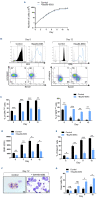Adenosine signaling inhibits erythropoiesis and promotes myeloid differentiation
- PMID: 37199120
- PMCID: PMC10772517
- DOI: 10.3324/haematol.2022.281823
Adenosine signaling inhibits erythropoiesis and promotes myeloid differentiation
Abstract
Intracellular uptake of adenosine is essential for optimal erythroid commitment and differentiation of hematopoietic progenitor cells. The role of adenosine signaling is well documented in the regulation of blood flow, cell proliferation, apoptosis, and stem cell regeneration. However, the role of adenosine signaling in hematopoiesis remains unclear. In this study, we show that adenosine signaling inhibits the proliferation of erythroid precursors by activating the p53 pathway and hampers the terminal erythroid maturation. Furthermore, we demonstrate that the activation of specific adenosine receptors promotes myelopoiesis. Overall, our findings indicate that extracellular adenosine could be a new player in the regulation of hematopoiesis.
Figures





Comment in
-
The double-edged sword of adenosine.Haematologica. 2024 Jan 1;109(1):13-15. doi: 10.3324/haematol.2023.283469. Haematologica. 2024. PMID: 37470140 Free PMC article. No abstract available.
References
-
- Oburoglu L, Romano M, Taylor N, Kinet S. Metabolic regulation of hematopoietic stem cell commitment and erythroid differentiation. Curr Opin Hematol. 2016;23(3):198-205. - PubMed
-
- Oburoglu L, Tardito S, Fritz V, et al. . Glucose and glutamine metabolism regulate human hematopoietic stem cell lineage specification. Cell Stem Cell. 2014;15(2):169-184. - PubMed
Publication types
MeSH terms
Substances
LinkOut - more resources
Full Text Sources
Research Materials
Miscellaneous

